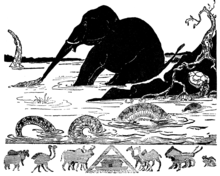Pourquoi story
Appearance
Apourquoi story[a](French pronunciation:[puʁ.kwa];"pourquoi"meaning" why "inFrench) is afictionalnarrativethat explains why something is the way it is, for example whysnakeshaveno legsor whytigershavestriped coats.Manylegends,origin mythsandfolk talesare pourquoi stories.[1][2]A more pejorative term for these stories is ajust-so story,coined by English writerRudyard Kiplingin 1902.
Examples
[edit]
Pourquoi stories include:
- Just So StoriesbyRudyard Kipling,many of which give explanations for the origin of animals and their characteristics.
- Australian Aboriginaldreamtime stories,such as theRainbow Serpent.
- Certaintall talesinclude pourquoi elements, such asPecos Billtaming his horse, Widowmaker. The horse bucked and kicked so much that she dug out the Grand Canyon.
- TheEpic of Gilgameshincludes many pourquoi stories from Mesopotamian folklore, such as how the Beqa'a Valley was formed, why meat becomes rancid when left in the rain, and why snakes shed their skins while people (who are mortal) do not.
- Origin stories,explaining how acomic bookheroor heroine came to have their special characteristics.
- Alamat,very loosely translated into "legend," are stories in Philippine folk literature which explain how things came to be. They normally involve people being transformed into animals and plants because of certain untoward habits they have. An example would be the Alamat of the Pineapple where a girl who is too lazy to look for things is transformed into a fruit with numerous "eyes."
- Tinga Tinga Talesinclude many pourquoi stories from African cultures, such as "Why Giraffe has a Long Neck," "Why Crocodile has a Bumpy Back," "Why Moles Live Underground," and many more.
See also
[edit]Notes
[edit]- ^Also known as anorigin story,pourquoi tale,or anetiological tale.
References
[edit]- ^Stern, Celia M. (1940). "Insatiable Curiosity Experiences with" Pourquoi "Tales".Childhood Education.16(5): 211–213.doi:10.1080/00094056.1940.10724447.ISSN0009-4056.
- ^Mallette, Dan (2013)."Pourquoi Stories".Understanding by Design: Complete Collection.
